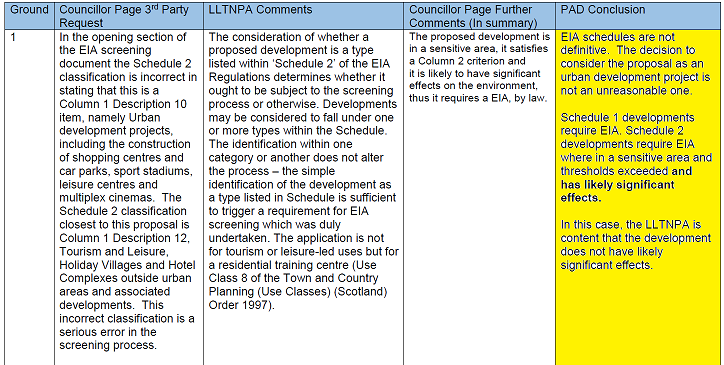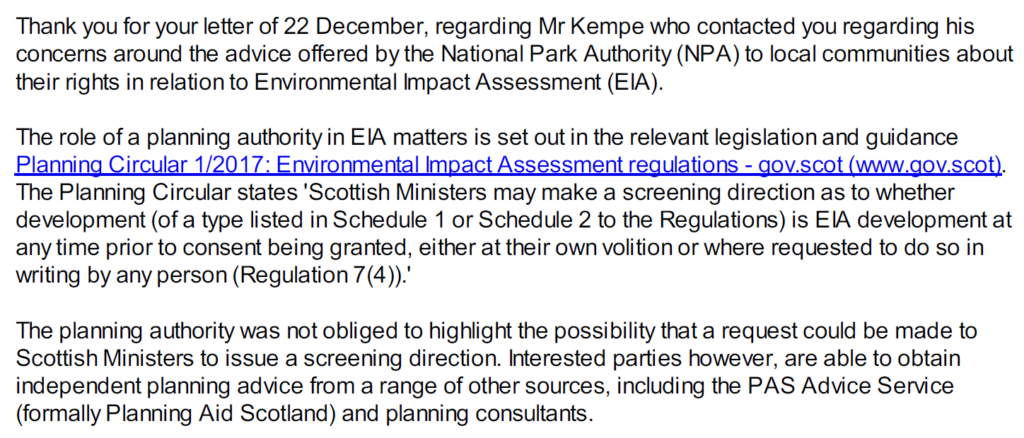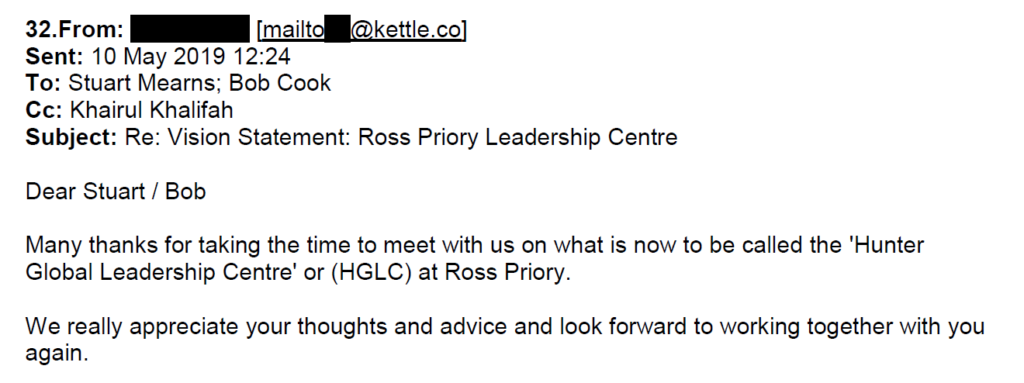
On Friday the Scottish Government’s Planning and Environmental Appeals Division rejected a request from the local community at Gartocharn that the Loch Lomond and Trossachs National Park Authority (LLTNPA) should have required the Hunter Foundation to conduct an Environmental Impact Assessment (EIA) before approving their planning application at Ross Priory.
The reasons for the decision are not (yet?) public on the Department of Planning and Environment Appeals website (see here) but the decision letter is circulating in the local community (see above). The decision means that Sir Tom Hunter has effectively been given the all-clear for a development that is on the last undeveloped section of shoreline at the south end of Loch Lomond, in the most prominent position possible (see here). PAD, however, found that the LLTNPA decision to classify the development at Ross Priory as an “Urban Development Project”, which circumvented the need for an EIA, was “not unreasonable”.
So, now we know! According to the planners the bonnie banks and presumably all the other scenic places in the Loch Lomond and Trossachs National Park can be classified as just another bit of urban sprawl. Any word, it seems, can be manipulated to mean its opposite. In the world of planning, our finest natural landscapes have no value.
How those responsible for the planning system in the National Park justify it
I sent my post about the LLTNPA’s failure to conduct an EIA (see here) to the local MSP for Gartocharn, Jackie Baillie. She asked both the Scottish Government and the LLTNPA about why the local community, having raised concerns about the lack of an EIA, were not advised of their right to seek a screening from Scottish Ministers. She has received answers from the very top, for which I am very grateful. I have not discussed either response with Ms Baillie and the commentary is mine alone. First, the letter from the Minister, Kevin Stewart:

The key words are in the final paragraph, the LLTNPA “was not obliged to highlight the possibility that a request could be make to Scottish Ministers to issue a screening opinion”. This ducks the point.
The issue is not about whether the LLTNPA was legally obliged to inform people in the local community of their rights, its whether morally they should have done so. The Minister is completely silent about that. It shouldn’t have been difficult. The LLTNPA knew people in the local community were concerned about the lack of an EIA, but rather than say “you know you always have the option of seeking an opinion from Scottish Ministers” they kept silent and pushed ahead with the planning meeting. The Minister’s response provides more evidence that the screeds of Scottish Government policy documents about the importance of involving local communities in the planning process are not worth the paper they are written on.
The response from the Chief Executive of the LLTNPA, Gordon Watson (see here for full email), is even more revealing. It shows that the planning system in the Park is systematically biased in favour of developers. It starts with the usual parkspeak, for example:
“At this [i.e the planning] meeting the Committee heard from some of those who were opposed to the application and from the applicant. The Committee received a comprehensive Officer’s report. Committee Members asked questions of Officers and those for and against in coming to their decision. This was a carefully considered application.”
Comment: note the opinion presented as fact, the “Comprehensive Officer’s report”, which made no mention of the nesting ospreys, and the “carefully considered” application which treated Hunter’s proposals as “an urban development”. After a whole lot more “considered conclusions” and “robust assessments” Mr Watson gets to the point:
“The relevant EIA regulations provide the ability for requests to be made to Scottish Ministers for a Screening Opinion in certain circumstances, which I presume is what Mr Kempe is referring to”.
Comment: note the “presume”. If you check the letter, Jackie Baillie couldn’t have been clearer, but a favoured tactic of the LLTNPA is to try and undermine critics by implying they don’t know what they are talking about. And then, after some more explanation about the process:
“It is not appropriate for a planning authority to proactively advise either applicants, those in objection or in support of an application on all legal rights or recourse. We must remain impartial and independent in our determination and handling of applications. We will always assist all interested parties where we can and as appropriate. For example, we received a number of queries in respect of this case and Officer’s made time to help answer these queries and questions as they always do. This included individuals from the local community.”
This is garbage. The Planning System encourages developers to seek advice from the Planning Authority before making any planning application and we know from the Ross Priory email correspondence obtained through FOI that the LLTNPA spent months advising the Hunter Foundation not just on the planning rules, but how to get its development through the system. Here is an example:

This shows that Stuart Mearns, the Head of Planning no less, advised the consultants acting on behalf of the Hunter Foundation of how to progress the application. But the same Mr Mearns, according to Mr Watson, would NOT have been acting impartially had he had responded to community concerns about the lack of an EIA by advising them of their rights. Instead of apologising for this failure, Mr Watson then ties himself in knots claiming “we will always help all interested parties”. So which is it?
Then, In response to Jackie Baillie’s “Mr Kempe is extremely concerned that the National Park do not advise local communities of their rights and the neutrality of the planning process” , Mr Watson’s email states:
“It is disappointing to read of these concerns. It must be recognised that the Park Authority in undertaking its statutory planning functions must remain impartial and independent of all interested parties when determining planning applications. It cannot advise or advocate on a particular course of action.”
Again, this misrepresents the facts. No-one is claiming the LLTNPA should have “advocated” the local community should seek a screening opinion from Scottish Ministers, only that they should have advised them of their right to do so.
The bias towards developers that drives the planning system in the National Park
Just after New Year the LLTNPA, under pressure as a result of adverse media publicity, issued a news statement on the Flamingo Land and Ross Priory planning applications. These quote Mr Watson and start with the spin that the LLTNPA “takes its environmental responsibilities extremely seriously undertaking a wide range of work to tackle both the nature and climate emergencies”. Like allowing the Ross Priory development in close proximity to the Nature Nature Reserve while willfully ignoring the carbon implications (an estimated 1000-1500 tonnes of CO2 created by the construction and the lack of any public transport)?
Mr Watson then proceeded to repeat a lie that dates back to 2017:
“The decision to appoint Flamingoland as preferred bidder for the West Riverside site was made by Scottish Enterprise alone. While a former member of the National Park Authority’s tourism team did provide informal tourism advice to Scottish Enterprise before their decision, no member of the planning team or any member of the National Park Board was involved in their selection and there was no conflict of interest”
As I showed almost four years ago (see here) LLTNPA was on the interview panel for Flamingo Land, involved in designing the scoring process and, according to Scottish Enterprise, “All the proposals were scored by a panel comprising of representatives from SE, LLTNPA and SE’s Property Advisors (Bilfinger GVA)”.
I have since been informed that Fiona Logan, former Chief Executive of the LLTNPA, may have visited Flamingo Land at their base in Yorkshire prior to them submitting a formal bid for the site. Yet Mr Watson, who almost certainly gave his consent for the member of staff to be on the interview panel, claims the LLTNPA was not involved.
In the context of the Ross Priory Planning Application, however, it is important to appreciate that the LLTNPA does not favour all developers equally. Developers are required to play the game that keeps the planners and the planning consultants in their jobs, an expensive business. 18 months ago the LLTNPA rejected a significant development at Ward’s Farm (see here), 1.5 km from Ross Priory but in a far less prominent location:
“The Visitor Experience Policies as set out in the Local Development Plan, and associated Planning Guidance, provides for areas within the National Park where larger scale development can be supported. This is not such a location. It is a more sensitive location –particularly given its proximity to a comprehensive range of sites designated for their natural heritage and landscape significance.”
On first reading a completely different approach to the Hunter Foundation application but the LLTNPA added some weasel words at the end:
“Sufficient justification has not been provided to enable an exception to these policies to be supported in this location.The proposed development would not integrate well with its surroundings.”
If you are rich enough to play the game, as the Hunter Foundation undoubtably is, there is almost nothing to stop you developing almost anywhere in the National Park, as long as you can “integrate” your proposal “with its surroundings”. And, if you are famous and well-connected to boot, the LLTNPA will fall over itself to oblige whatever local communities think.
This shows that Stuart Mearns, the Head of Planning no less, advised the consultants acting on behalf of the Hunter Foundation of how to progress the application. But the same Mr Mearns, according to Mr Watson, would have been acting impartially had he had responded to community concerns about the lack of an EIA by advising them of their rights. Instead of apologising for this failure, Mr Watson then ties himself in knots claiming “we will always help all interested parties”. So which is it?
Should this paragraph not say ‘would NOT have been acting impartially’?
June, thank you, I have fixed, Nick
This is an astounding catalogue of events. One couldn’t make it up! Surely it is time that more cognisance is given to the founding act of National Parks (Scotland) Act 2000.These are the principles by which our National Parks are MEANT to operate. The first of these principles being ‘to conserve and enhance the natural and cultural heritage of the area’. How does a glass and concrete village at the very edge of Loch Lomond with it’s world-renowned natural beauty fit with that? What an eyesore when viewed from the loch itself – glaring reflection at times from the sun and light pollution at others. Of course, that aspect has been ignored along with all the others in the objections from members of the public. Have the Park Board forgotten the Board Meeting 24th October 2019 held at Kinlochard Community Hall? It too is glass fronted overlooking Loch Ard. A beautiful but chilly autumnal day with the sun shining – the blinds had to be pulled down because no-one facing the windows could see for the reflection of the sun on the water!! It is, perhaps, worth noting that Cairngorm National Park (CNPA) operates under a different system as regards Planning. Planning Applications are made to the Local Authorities within the CNPA and most applications are determined by them. Only occasionally are applications ‘called in’ by CNPA. They have the power to ‘call in’ the bigger or more sensitive applications from the Local Authorities. Thus, Planning Applications are mainly handled by those ELECTED to their decision-making positions and are answerable to their ELECTORATE. Notably West Dunbartonshire Council voted against the hugely unpopular proposal of Flamingoland at Balloch. Was it recognised when setting up CNPA what a faux pas had been made in giving planning powers to LLTNPA when the same powers were not granted to CNPA which came along later??
Yet another disgraceful episode in the history of LLTNPA, and well exposed in this article. The problem is unless the politicians in opposition parties do even more to expose the inappropriate behaviour of Government ministers, their civil servants and planning authorities, these examples will continue to happen. The one skill set we should never underestimate is the ‘skill’ which Government ministers and these officials have to ride out the storm, no matter how badly they have performed or behaved.
Relevant to the way local communities have been ignored and disregarded to near to the point of insulting them, is the Government consultation on National Planning Framework 4 which closes on 19 February. The proposed framework has many warm words about increased community involvement, questioning development for development’s sake and using the climate emergency as a measure to determine whether a development should proceed. Sounds great, but how many times have we heard these platitudes from our Scottish Government? We need to be very sceptical about the form of the new NPF4 and they way it will be implemented – after all can this ‘leopard ever change its spots’? I very much doubt it.
Interesting EIA Scope notification has appeared on the LLTNPA Planning Portal in week 5 which is the current one today 11/2/21. 8. Other Planning Issues Week number: 5 Date: 1 February 2021 Ref No PSC/2021/0002 Officer Caroline Strugnell Date Valid 2 February 2021 Telephone 01389 722 148 Proposal EIA Screening request Location RSPB High Wards Farm Gartocharn Applicant Paula Baker RSPB Loch Lomond High Wards Farm Gartocharn G83 8SB Agent Application Type Pre Screening / Scoping Requests Expected Decision Level National Park Ward NP Ward 4 (south east Loch Lomond) Community Council Area Kilmaronock CC National Grid co-ordinates 243989 E 687224 N Advertisement Type
Is this another one that should have been done previously??